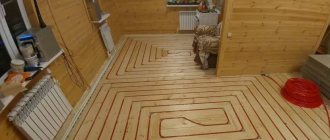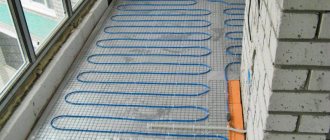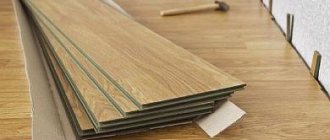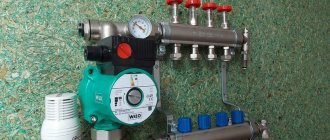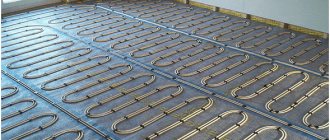REXANT screwdriver with bit set for spot work, iPhone repair, 6 pieces
252 ₽ More details
Combination screwdriver with double-sided rod (PH2xSL6)
149 ₽ More details
REXANT solders
There is an opinion that to provide electric floor heating, it is enough to simply place a heating cable on it. The opinion is correct, but in this case it is necessary to take into account the varieties of this device. In addition, sometimes it is much easier and more profitable to simply place a warming mat. However, underfloor heating cable is the most common solution to this problem.
Often, it is the heating cable that becomes the choice for underfloor heating.
The advantage of heated floors
- Does not take up additional space, which allows you to implement design ideas.
- Guarantee that there are no drafts in the house. The heat evenly rises by 2-2.5 meters, which is ideal for warming up the apartment.
- Electric models are equipped with a heat regulator, which allows you to control the temperature according to the outside temperature.
- The air does not dry out and the optimal humidity of the room is maintained.
- Compared to traditional heaters, it warms up the room faster.
- Heating systems are hidden from prying eyes, which does not spoil the external style of the room.
Which cable is best to choose for underfloor heating: characteristics
When choosing, it is important to consider the following nuances:
- The price of the product should not be very low, because such a cable can quickly fail. Therefore, it is better not to skimp, but to take a trusted manufacturer that will last longer.
- Consider installation costs. The resistive option requires additional investment in the purchase of a temperature controller. When choosing a self-regulating option, purchasing such a regulator is not required. For a large room, it is recommended to select a resistive type wire. If in the future a rug will be placed on the floor, then it is worth purchasing a self-regulating wire to prevent local overheating.
- To decide on a cable for a heated floor, it is worth considering the functionality that will be assigned to it. For direct heating, a two-core or single-core cable or a heat mat is suitable. Before installing the floor covering, such products are laid in a thin layer of screed. This approach allows you to warm up the room in a short time. If the function is to accumulate heat, then it is worth using a self-regulating or two-core resistive cable. In this case, the system can cope with heating concrete with a thickness of 5 cm.
When choosing a cable, it is important to take into account many nuances, because this is the only way to achieve high-quality system operation.
Two-core
One core is used to generate heat, the second to provide electric current. The installation process does not require installing the two ends of the cable at one point. The two-core model has a return core and an additional insulating coating, which guarantees safety during cable operation. The main difference between a two-core and a single-core wire is that the latter will have to be returned to the thermostat.
Single core cables
Provides heat transfer along the entire length. The disadvantage of such a cable is a possible overheating point. Some areas of the flooring will be too hot. When installing, you must ensure that both ends are at the same point.
Operating principle of ETP
In the case of heating wire and mats, the conductor is heated under the influence of the electric current flowing in it. The wire heats the screed, which in turn heats the finish coating. Heating occurs by convection.
In the case of using infrared film, heating occurs by thermal radiation of the carbon layer, which occurs under the influence of electric current. This radiation heats the finish coating and objects located close enough to the floor. They heat the air in the room by convection.
Temperature regulation is carried out using a temperature sensor and a thermostat through which the heated floor is connected.
What wire gauge is needed?
The maximum current for thermostats is 16 A, the load is 3.5 kW. If the floor is connected to one thermostat and the total power of the system does not exceed 3.5 kW, then a pickup point with a cross-section of 1.5 mm2 is suitable for operation. If this figure is higher, then you should pay attention to models with a larger cross-section. So a model with a cross section of 2.5 mm2 can withstand a load of 25A.
The maximum current of the regulator should not be greater than the total current consumed. Otherwise, there is a risk that the thermostat will fail. Using an additional relay or another thermostat can solve the problem without replacing the wire.
If you still find it difficult to choose a section, it is recommended to pay attention to the data in the table.
Table of approximate power of electrical appliances
To independently calculate power consumption, the voltage value and source strength are important.
Power indicators (P) in this case are calculated by multiplying the current strength with the mains voltage indicator.
Average power of the most common energy-dependent household appliances
| Device | Power, kWt) |
| Water heating equipment | 1,2-1,5 |
| DVD player | 0,3 |
| Pump equipment | 0,25 |
| Video recorder | 0,04 |
| Grill | 1,2-2,0 |
| Halogen light source | 0,1 |
| Drill | 0,15-0,8 |
| Razor | 7.0 W |
| CD player | 7.0 W |
| Mobile phone charger | 0,025 |
| Oven | 1,0-2,0 |
| Air conditioner | 1,0-3,0 |
| Record player | 0,01-0,03 |
| Game console | 0,01-0,03 |
| Coffee maker | 0,6-1,5 |
| Incandescent lamp | 0,02-0,25 |
| Fluorescent gas-discharge light sources | 0,25-0,6 |
| Freezer | 0,7 |
| Microwave | 1,5-2,0 |
| Table fan | 0,042 |
| Music Center | 0,05-0,5 |
| Heater | 1,0-2,4 |
| Laptop | 0,08 |
| Personal Computer | 0,28-0,75 |
| Soldering iron | 0,025-0,12 |
| Vacuum cleaner | 0,4-2,0 |
| Printer | 0,35 |
| Scanner | 0,015-0,1 |
| Mixer | 0,18 |
| Heat fan | 1,5 |
| Washing machine | 4,0 |
| Iron | 0,25-2,0 |
| Toaster | 0,6-1,5 |
| Hairdryer | 1,0 |
| Fax | 0,6 |
| TV | 0,07-0,2 |
| Fridge | 0,15-0,6 |
| Electric jigsaw | 0,4-0,8 |
| Electric heater | 0,2 |
| Electric kettle | 1,0-2,5 |
| Electric stove | 1,1-6,0 |
| Energy saving light source | 0,08-0,1 |
Approximate power indicators of a volatile device are represented by the product of current and voltage, so the standard simple formula P = I × V is used for calculations.
Laying wires in a screed under heated floors with your own hands
Installation of the heating cable is carried out in several stages:
- A cement-sand screed with a thickness of at least 3 cm is poured. To lay the wire that will pass to the thermostat, you will have to cut a channel, the diameter of which is within 2 cm.
- Installation of a heat-reflecting substrate layer.
- Installation of reinforcing mesh on which the cable is fixed. If you do not use a mesh, you will have to install tape. The product should not be placed under furniture.
- The wire is being laid.
- The heat sink is installed in a special corrugated tube and placed in a groove.
- A cement screed, 4 cm thick, is poured. Ohmic resistance and insulation resistance are indicators that should be established to determine the performance of the cable after pouring. Laying the floor covering is carried out after the solution has completely dried, which will not happen earlier than a month.
When carrying out installation work, it is important to follow the following installation rules:
- Avoid loops in the cable. Individual sections should not intersect.
- According to safety rules, the location of heating systems from metal structures should be 5 cm, from wooden structures - 3 cm, but from other heat sources - 50 cm.
- Follow the laying step, focusing on 6-10 outer diameters of the wire.
- The hot part of the wire must be in insulating material.
- When laying inside the screed, the cable pitch is 20 cm, when arranging a direct floor - 10 cm.
- The batteries are not connected directly to the network; a regulator is used for this.
- The thermostat is installed 50-150 cm from the floor.
- The use of twists is prohibited, connections only through special terminals.
- To avoid power surges, it is necessary to use circuit breakers.
Before carrying out installation work, everyone can study the presented videos on this topic on the Internet.
It’s better to choose a cable or mat
The cable consists of one or more cores with insulation and an outer sheath.
Installation of such a wire will be carried out in a tie, the thickness of which is 3–5 cm. It is recommended to install the cable under:
ceramic tiles, porcelain stoneware, natural stone, self-leveling flooring, laminate, parquet boards, PVC tiles, linoleum, carpet.
This floor can be called almost universal.
There are two types of mats on the market – convection and infrared. This cable is thinner and is fixed at the correct distance on a mesh base. Mats take up less space; a smaller screed thickness of up to 5-10 mm is required. Installation is simple and does not increase the planned height.
Simple installation often determines the choice in favor of a mat. The film is laid lengthwise on a thin layer of thermal insulation, and the floor covering is installed on top. Unlike the first option, you do not have to make a screed and fill the floor with cement. This approach allows you to use mats on a vertical surface. Having assessed the advantages of the presented materials, many prefer the latter. Such efficiency and ease of installation captivates many users, which is why the popularity of mate flooring is growing every day. It's worth watching the video once to learn the editing technology.
Warm floors are the key to comfort for home residents. It can be an auxiliary element of the heating system or replace it. The main advantage is ease of installation and significant savings in resources. But for the system to function correctly, you need to select the right cable. The selection criteria are very diverse - from the cross-section to the expected load. Be sure to decide on the functionality to be assigned to the heated floor. Then the cable selection process can be greatly simplified.
You can make a warm floor yourself using simple panels that can be installed even without pouring cement. It is worth carrying out installation procedures to evaluate the benefits of heated floors in action.
The most common concerns
Now regarding the concerns mentioned at the beginning:
- “It will work for several months, and then it will stop heating.” The semiconductor matrix actually loses power during operation. But properly installed high-quality cables work for quite a long time, at least several years (in accordance with the technical characteristics and manufacturer’s warranties for specific brands, usually at least 10–15 years ).
- “Electricity bills will go up.” They will really grow. The heated floor will heat up, consuming electricity. But it is the self-regulating cable that is relatively economical due to the change in power consumption depending on the heat transfer conditions.
- “The wiring will burn out.” This will only happen if the installation is improper. If you take into account the load, lay power cables and wires of sufficient cross-section, install a high-quality circuit breaker and RCD, there should be no problems with the wiring.
- “There will be an electric shock.” Similar to the previous case - if everything is done correctly, there will be no fighting. Moreover, good self-regulating cables have a metal braid that must be grounded, which will minimize any current leakage - if the insulation is damaged, the RCD (or the circuit breaker itself) will simply turn off the electric current.
- "Expensive". There are now a wide variety of brands on the market at different prices. But in this case, you should not go for cheapness, since it is better to install a high-quality cable in the floor, because replacing it is a very complex and costly process.
